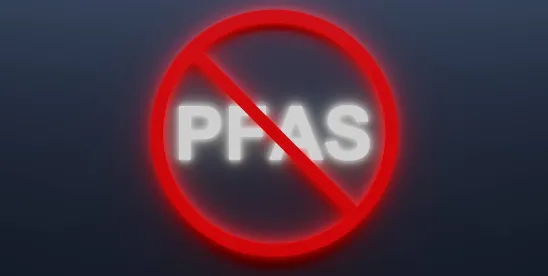Per- and polyfluoroalkyl substances (PFAS) remain a top concern for regulators and the public alike. While federal regulators continue to lay the groundwork for a comprehensive response, including through the PFAS Strategic Roadmap, states are increasingly positioning themselves as policy innovators in this space. The recent announcement that the U.S. Environmental Protection Agency (EPA) will issue additional guidance and extend the compliance deadline for the Toxic Substances Control Act (TSCA) Section 8(a)(7) PFAS reporting rule underscores a broader dynamic: in the absence of fast-moving federal action that states perceive as comprehensive, states are setting the pace, even if their approaches do not always (or ever) mirror the federal approach to regulation and risk mitigation.
Federal Rulemaking Slows, States Surge Ahead
EPA issued in final the TSCA Section 8(a)(7) PFAS reporting rule in October 2023 to obtain historical data on PFAS manufactured or imported since 2011. Following significant stakeholder pushback over the reporting burden and the scope of the information required, EPA announced on May 13, 2025, that it extended by direct interim final rule the reporting deadline to October 2026 (longer for small business). EPA also signaled its receptivity to revisiting the contours of the core reporting rule — music to many corporate ears.
While this federal delay, and retreat in other PFAS areas, is recent, states have not waited for federal action. Over the past few years, several states have increasingly framed PFAS regulation as a space for environmental leadership, and their regulatory approaches diverge significantly from federal approaches to PFAS regulation.
PFAS Trendsetting: State-by-State
States have introduced wide-ranging PFAS policies aimed at consumer products, environmental media, and public health surveillance. Notably, many of these state efforts include categorical bans and reporting obligations that would be difficult to implement under TSCA without extensive TSCA rulemaking.
- Maine’s landmark PFAS in Products Program, An Act To Stop Perfluoroalkyl and Polyfluoroalkyl Substances Pollution, enacted in 2021 and most recently amended in 2024, first prohibits intentionally added PFAS in certain consumer products before setting an ambitious timeline to eliminate most uses by 2032, while also allowing industry to submit currently unavoidable use (CUU) proposals. The 2021 statute required manufacturers to report the presence of intentionally added PFAS, but after several postponements, the legislature amended the statute so that only products with CUU determinations will be required to report. While implementation has faced logistical hurdles, the law positions Maine as a national trendsetter.
- California continues to expand its PFAS regulatory portfolio through targeted legislation. Recent laws prohibit PFAS in juvenile products, food packaging, textile articles (including apparel, bedding, handbags, and upholstery), and menstrual products, while adding numerous PFAS chemicals to the Proposition 65 list. This piecemeal approach prompted Governor Gavin Newsom (D) to veto three bills in 2023 that separately addressed PFAS.
- Colorado’s HB22-1345, passed in 2022, phases out PFAS in products such as carpets, cosmetics, and firefighting foam, and includes a labeling requirement for cookware that contains intentionally added PFAS. The labeling requirement took effect January 1, 2024, yet the same month that the labeling requirement took effect, SB24-081 was introduced. Enacted on May 1, 2024, the bill repeals the labeling requirement for cookware effective January 1, 2026, when cookware containing intentionally added PFAS is banned, as well as certain other consumer products containing intentionally added PFAS. This legislative one-two for cookware reinforces the idea that while consumer product restrictions are a primary policy tool for many states, the states may not have a long-term view in mind.
- Minnesota passed Amara’s Law in 2023, and it was modeled after Maine’s 2021 statute — intentionally added PFAS were banned in certain consumer products on January 1, 2025; reporting on intentionally added PFAS will be required on or before January 1, 2026; and effective January 1, 2032, intentionally added PFAS will be banned in all products that are not exempt and do not have a CUU determination.
- Connecticut and Vermont both enacted laws in 2024, with Vermont’s law (S25) restricting certain chemicals, including PFAS, in cosmetic and menstrual products and Connecticut’s statute (S.B. No. 292) banning intentionally added PFAS in certain consumer products and mandating disclosure and reporting.
- New Mexico’s HB 212, the most recently enacted statute, is similar to Minnesota’s in that it will phase out certain consumer products containing intentionally added PFAS, require reporting, and ultimately ban products containing intentionally added PFAS that are not exempt or that do not have a CUU determination. New Mexico is unique among enacted legislation to date in that it distinguishes fluoropolymers. Products that contain only intentionally added fluoropolymers are exempt from both the reporting requirements and prohibition.
Leadership or Fragmentation?
While many states are eager to demonstrate environmental leadership, the result for industry is a fragmented landscape. State definitions of intentionally added PFAS vary, as do timelines, disclosure requirements, and enforcement approaches. Moreover, some states are advancing policies that would be difficult to replicate under federal law without significant evidentiary support or economic impact analysis — processes TSCA requires but state legislatures often bypass.
For companies operating across jurisdictions, this growing divergence raises compliance challenges and highlights the need to monitor both federal and state developments, along with a growing number of international measures. Safer States maintains a table of PFAS bans in key sectors with implementation dates.
Looking Ahead
EPA’s decision to extend the reporting window under TSCA Section 8(a)(7) may not have triggered state action, but it reinforces a pattern that has been building for years: states are not waiting for federal consensus before moving forward on PFAS. Whether these policies ultimately converge or further diverge remains to be seen, but what is clear is that PFAS compliance is increasingly being shaped by state leadership — and companies will need to navigate that evolving terrain carefully.




 />i
/>i

